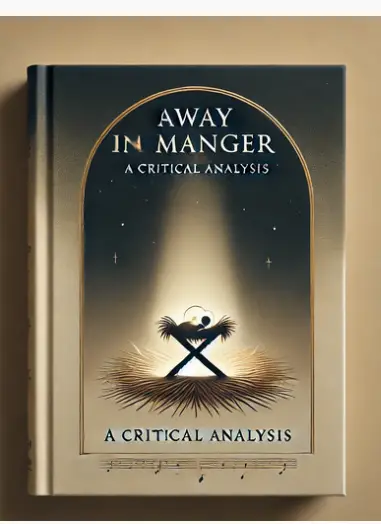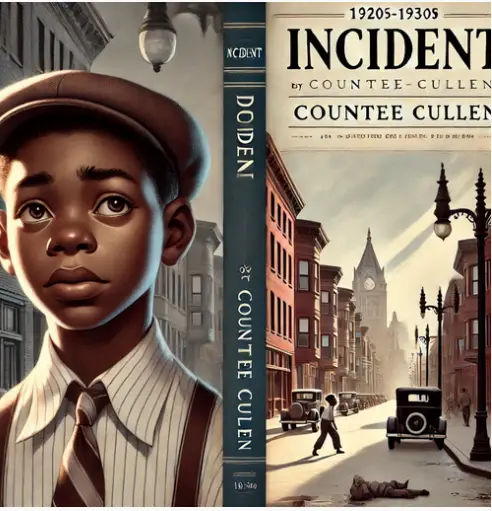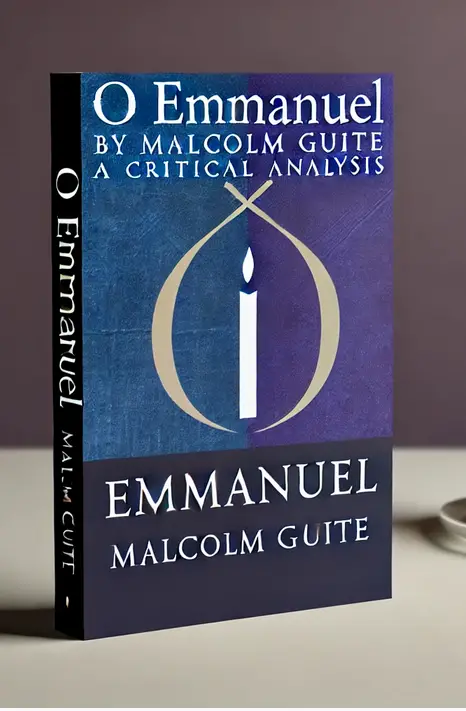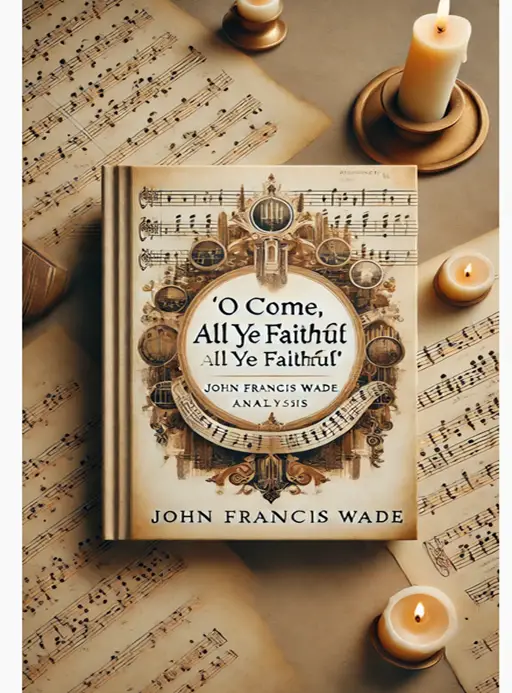
Introduction: “Away in a Manger”
“Away in a Manger” first appeared as a poem written by an anonymous author in 1887, later adapted into a carol sung by Lydia Newell. The carol’s simple, lyrical melody and tender imagery have made it a beloved Christmas tradition. Its main idea is the humble birth of Jesus Christ in a manger, emphasizing the contrast between his divine nature and his earthly surroundings. The carol’s message of peace, hope, and joy resonates with people of all ages and backgrounds.
Text: “Away in a Manger”
1 Away in a manger, no crib for a bed,
the little Lord Jesus laid down His sweet head;
the stars in the heavens looked down where He lay,
the little Lord Jesus asleep on the hay.
2 The cattle are lowing, the Baby awakes,
but little Lord Jesus, no crying He makes.
I love Thee, Lord Jesus, look down from the sky
and stay by my side until morning is nigh.
3 Be near me, Lord Jesus; I ask Thee to stay
close by me forever, and love me, I pray.
Bless all the dear children in Thy tender care,
and fit us for heaven, to live with Thee there.
Annotations: “Away in a Manger”
| Line | Annotation |
| 1 | “Away in a manger”: This line sets the scene of the carol, emphasizing the humble and modest birthplace of Jesus. |
| 2 | “No crib for a bed”: This line further emphasizes the simplicity and poverty of the situation, contrasting with the divine nature of the child. |
| 3 | “The little Lord Jesus laid down His sweet head”: This line portrays Jesus as a vulnerable and innocent baby. |
| 4 | “The stars in the heavens looked down where He lay”: This line suggests the divine nature of Jesus, as even the heavenly bodies are watching over him. |
| 5 | “The little Lord Jesus asleep on the hay”: This line continues to emphasize the simplicity of the scene, contrasting with the grandeur of the event. |
| 6 | “The cattle are lowing, the Baby awakes”: This line introduces a sense of peace and tranquility, as even the animals seem to be aware of the divine presence. |
| 7 | “But little Lord Jesus, no crying He makes”: This line further emphasizes the miraculous nature of the event, as Jesus, despite being a newborn, does not cry. |
| 8 | “I love Thee, Lord Jesus, look down from the sky”: This line marks a shift from narration to prayer, as the singer expresses their love and devotion to Jesus. |
| 9 | “And stay by my side until morning is nigh”: This line continues the prayer, asking for Jesus’s constant presence and protection. |
| 10 | “Be near me, Lord Jesus; I ask Thee to stay”: This line repeats the plea for Jesus’s presence, emphasizing the singer’s deep need for him. |
| 11 | “Close by me forever, and love me, I pray”: This line expresses the singer’s desire for a lifelong relationship with Jesus, based on love and trust. |
| 12 | “Bless all the dear children in Thy tender care”: This line extends the prayer to include all children, asking for Jesus’s blessing and protection. |
| 13 | “And fit us for heaven, to live with Thee there”: This line concludes the prayer, asking for Jesus’s help in preparing for eternal life with him in heaven. |
Literary And Poetic Devices: “Away in a Manger”
| Device | Definition | Example | Explanation |
| Alliteration | Repetition of the same sound at the beginning of adjacent words. | ‘the little Lord Jesus laid down His sweet head’ (Repetition of ‘l’). | Creates rhythm and can highlight certain words. |
| Allusion | A brief reference to a person, place, or event, often from literature or religion. | ‘the little Lord Jesus’ (Biblical allusion to Jesus Christ). | Connects the text to broader themes and contexts. |
| Anaphora | Repetition of a word or phrase at the beginning of successive clauses or lines. | ‘the little Lord Jesus’ (Repetition of ‘the’ at the start of each phrase). | Adds emphasis and rhythm to a passage. |
| Assonance | Repetition of vowel sounds within words. | ‘Away in a manger’ (Repetition of the ‘a’ sound). | Creates musicality and enhances the mood. |
| Caesura | A pause within a line of poetry, often marked by punctuation. | A natural pause between ‘bed’ and ‘the’ in the first line. | Forces the reader to pause, adding a moment of reflection. |
| Consonance | Repetition of consonant sounds, typically at the end of words. | ‘the stars in the heavens looked down’ (Repetition of ‘n’ sound). | Adds harmony and can create a musical effect. |
| Couplet | Two consecutive rhyming lines of poetry. | The entire poem consists of rhyming couplets. | Provides a sense of completion and structure. |
| Enjambment | Continuation of a sentence beyond the end of a line of poetry. | ‘the little Lord Jesus laid down His sweet head; the stars in the heavens looked down’ (One line carries into the next). | Builds a continuous flow of thought across lines. |
| Hyperbole | Exaggerated statements not meant to be taken literally. | ‘The cattle are lowing’ (Exaggeration to emphasize sounds). | Used to create a dramatic or humorous effect. |
| Imagery | Descriptive language that appeals to the senses. | ‘The stars in the heavens looked down’ (Appeals to the visual sense). | Engages the reader’s senses and helps create a vivid picture. |
| Internal Rhyme | Rhyme that occurs within a single line of poetry. | ‘the stars in the heavens looked down where He lay’ (Rhyme within the line). | Adds musicality and can unify a line or passage. |
| Irony | A contrast between expectations and reality. | Jesus sleeping peacefully despite being in a manger contrasts with the expected discomfort. | Often used to convey deeper meaning or contradiction. |
| Metaphor | A comparison between two unlike things without using ‘like’ or ‘as’. | ‘The Lord is my shepherd’ (Jesus metaphorically represented as a shepherd). | Gives abstract ideas more concrete form and vivid imagery. |
| Onomatopoeia | A word that imitates the sound it represents. | ‘lowing’ (Imitates the sound of cattle). | Adds realism by mimicking actual sounds. |
| Oxymoron | A combination of contradictory words. | ‘silent cry’ (Combines silence and crying). | Highlights contradictions or complex emotions. |
| Personification | Attributing human characteristics to non-human things. | ‘the stars looked down’ (Stars are given human-like behavior). | Makes abstract ideas more relatable by giving them human qualities. |
| Refrain | A repeated line or group of lines, often at the end of a stanza. | ‘the little Lord Jesus asleep on the hay’ (Refrain at the end of the stanza). | Reinforces the theme or mood through repetition. |
| Rhyme | Repetition of similar sounds at the end of lines. | ‘bed/head’, ‘lay/hay’ (End rhymes). | Enhances the musicality and rhythm of the poem. |
| Simile | A comparison using ‘like’ or ‘as’. | ‘Asleep on the hay like a little lamb’ (Comparison using ‘like’). | Creates vivid comparisons and helps convey meaning. |
| Symbolism | Using an object or action to represent a deeper meaning. | ‘the manger represents the humble beginnings of Jesus’ (Manger symbolizes humility). | Gives objects or actions deeper meaning, adding complexity. |
Themes: “Away in a Manger”
- Humility: The poem emphasizes the humble beginnings of Jesus, born in a simple manger rather than a grand setting. The first line, “Away in a manger, no crib for a bed,” illustrates the lack of luxury surrounding Jesus’ birth. This image of Jesus lying in a manger highlights his modest and humble entry into the world, a recurring theme in Christian teachings about Jesus’ life and mission.
- Innocence and Peace: The poem conveys a sense of peace and purity through the image of the baby Jesus. The line, “the little Lord Jesus, no crying He makes,” reflects the serene and innocent nature of Christ. His calmness, even in the midst of an unconventional and uncomfortable setting, suggests his divine nature and the idea of inner peace that transcends worldly circumstances.
- Divine Protection: A theme of divine guardianship runs through the poem, as seen in the request for Jesus to “stay by my side until morning is nigh.” This line expresses the speaker’s desire for God’s presence and protection, especially through the vulnerable times of life. The plea for Jesus to “be near me” represents the need for constant divine care, which is central to the Christian faith.
- Love and Prayer: The final stanza of the poem emphasizes love and prayer, as the speaker asks Jesus to “love me, I pray.” This request underscores the theme of devotion and spiritual connection. Additionally, the blessing for “all the dear children” to be under God’s “tender care” reflects the theme of unconditional love, which is fundamental to Christian teachings.
Literary Theories and “Away in a Manger”
| Literary Theory | Application to “Away in a Manger” | References |
| Deconstruction | This theory would examine the inherent contradictions and ambiguities within the poem, such as the juxtaposition of divine and earthly elements. For instance, the poem presents Jesus as both a divine savior and a vulnerable infant. | “The little Lord Jesus laid down His sweet head” and “The cattle are lowing, the Baby awakes” |
| Marxist Criticism | This theory would analyze the poem’s portrayal of class and power. In this case, the poem’s emphasis on the humble birth of Jesus could be seen as a critique of social hierarchies and a celebration of the working class. | “Away in a manger, no crib for a bed” |
| Psychoanalytic Criticism | This theory would explore the psychological dimensions of the poem, such as the symbolism of the manger and the figure of Jesus. For instance, the manger could be interpreted as a womb, symbolizing rebirth and renewal. | “Away in a manger” and “The little Lord Jesus laid down His sweet head” |
Critical Questions about “Away in a Manger”
- How does the poem’s portrayal of Jesus as a vulnerable infant challenge traditional conceptions of divinity?
- The poem presents Jesus as a helpless baby, sleeping in a manger and surrounded by animals. This image contrasts with the traditional depiction of God as a powerful and omnipotent being. For instance, the phrase “Away in a manger, no crib for a bed” suggests the simplicity and vulnerability of Jesus’s birth. It challenges the idea of a divine figure who is always in control and invulnerable.
- What is the significance of the setting of the poem, a manger, and how does it contribute to the overall theme?
- The manger, a humble and simple place, emphasizes the contrast between Jesus’s divine nature and his earthly surroundings. It suggests that even the most powerful and important figures can be born into humble circumstances. For example, the phrase “The little Lord Jesus laid down His sweet head” juxtaposes the divine nature of Jesus with the simplicity of his surroundings.
- How does the poem’s use of language and imagery evoke emotional responses in the reader?
- The poem employs simple, evocative language and vivid imagery to create a sense of tenderness and awe. Phrases like “laid down His sweet head” and “The stars in the heavens looked down” evoke strong emotional responses and help to connect the reader to the story. The poem’s use of sensory details, such as the “cattle are lowing” and the “little Lord Jesus asleep on the hay” creates a vivid and immersive experience for the reader.
- In what ways does the poem’s message of hope and peace resonate with contemporary audiences?
- The poem’s message of hope and peace, embodied in the birth of a savior, continues to resonate with people today. In a world often filled with uncertainty and conflict, the image of a newborn child can offer comfort and inspiration. For example, the phrase “Be near me, Lord Jesus; I ask Thee to stay” expresses a longing for peace and security, which is a sentiment that many people can relate to.
Literary Works Similar to “Away in a Manger”
- “Silent Night” by Joseph Mohr: Both poems emphasize the peaceful and humble circumstances of Jesus’ birth.
- “O Holy Night” by Placide Cappeau: This poem similarly reflects on the spiritual significance and reverence for the birth of Jesus.
- “The First Noel” (Traditional): Like “Away in a Manger”, this poem tells the story of the nativity with a focus on simplicity and devotion.
- “Infant Holy, Infant Lowly” (Traditional Polish Carol): Both poems highlight the lowly setting of Jesus’ birth and the innocence of the infant Christ.
- “In the Bleak Midwinter” by Christina Rossetti: This poem, like “Away in a Manger”, depicts the humble and cold surroundings of Jesus’ birth and the wonder of his arrival.
Representative Quotations of “Away in a Manger”
| Quotation | Context | Theoretical Perspective |
| “Away in a manger, no crib for a bed” | Describes Jesus’ humble birth setting, emphasizing the simplicity of his arrival. | Marxist Theory: Highlights the contrast between Jesus’ humble origins and the materialistic values of the world. |
| “The little Lord Jesus laid down His sweet head” | Refers to Jesus peacefully sleeping despite his surroundings. | Christian Symbolism: Jesus’ innocence and divinity are central to Christian narratives of peace and salvation. |
| “The stars in the heavens looked down where He lay” | Nature is witnessing the birth of Jesus, showing the significance of the event. | Ecocriticism: The natural world, represented by the stars, acknowledges the divine presence, linking nature and divinity. |
| “The cattle are lowing, the Baby awakes” | Describes the peaceful awakening of the baby Jesus amidst the sounds of animals. | Romanticism: Focuses on the purity and simplicity of nature as a backdrop for the divine. |
| “But little Lord Jesus, no crying He makes” | Highlights Jesus’ peacefulness and tranquility, even as an infant. | Religious Devotion: Reflects the ideal of a peaceful, divine figure who transcends human suffering and turmoil. |
| “I love Thee, Lord Jesus, look down from the sky” | Expresses a personal, heartfelt devotion to Jesus and a plea for his divine protection. | Theology of Love: Emphasizes the intimate, personal relationship between the individual and the divine. |
| “Stay by my side until morning is nigh” | A plea for Jesus’ protection through the night, symbolizing spiritual guidance. | Psychoanalytic Theory: Represents the human need for comfort, protection, and guidance in vulnerable times. |
| “Be near me, Lord Jesus; I ask Thee to stay” | A prayer for Jesus to remain close, symbolizing reliance on divine presence. | Existentialism: Reflects the human quest for meaning and the need for divine reassurance in an uncertain world. |
| “Bless all the dear children in Thy tender care” | A request for Jesus to bless and protect all children, showing concern for innocence. | Humanitarianism: Emphasizes the care and protection of the innocent, representing the ethical responsibility of society. |
| “And fit us for heaven, to live with Thee there” | A plea for spiritual preparation for the afterlife, indicating a desire for salvation. | Christian Eschatology: Focuses on the afterlife, salvation, and the belief in eternal life with God. |
Suggested Readings: “Away in a Manger”
- Balmer, Randall. The Oxford Encyclopedia of Religion in America. Oxford University Press, 2018.
- Eskew, Harry, and Hugh T. McElrath. Sing with Understanding: An Introduction to Christian Hymnology. Church Street Press, 2001.
- Kidson, Frank. Traditional Tunes: A Collection of Ballad Airs. Clarendon Press, 1891.
- Young, Carlton R. Companion to the United Methodist Hymnal. Abingdon Press, 1993.








